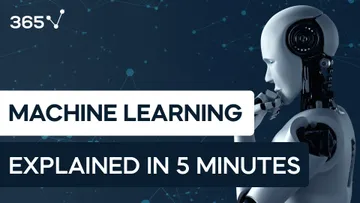A few years ago, a shrewd journalist came up with the headline that data scientist is ‘the sexiest job’ of the 21st century. And according to Glassdoor.com, ‘data scientist’ continues to be among the most desired career paths today.
Ironically, the term data science – first introduced in the 1980s – remains confusing for many people even now. A large number of individuals, particularly the ones outside the field, struggle to understand how data scientists help companies around the world and why their services are in such high demand.
There are a few key reasons for this.
In this article, we’ll shed light on the nature of data science, what its key aspects are, and how companies benefit from hiring skilled data scientists.
You can check out the video where we explain the data science field in less than 5 minutes embedded below, or scroll down to keep reading.
What Is Data Science?
First of all, data science is an interdisciplinary field. Its true foundations are in statistics, mathematics, computer science, and business. So, it is difficult to draw a clear separation line indicating what lies in the realm of data science and what doesn’t.
On a few occasions, people have claimed that data science and statistics are the same thing. However, we’d argue that data science is broader – it grows out of statistics and includes topics that are apt to deal with digital and big data.
Another frequent misconception is that data science and ArtificiaI Intelligence (AI) are interchangeable terms. AI designates a model – a machine if you will – which tries to mimic human behavior and produce human-like decisions.
It sometimes leverages data science methods such as Deep Learning but is not confined solely to them. For example, symbolic reasoning is a type of AI that does not necessarily have to be characterized as data science.
Machine Learning (ML) and Deep Learning (DL) are important domains within data science. And so is statistics.
Data science is, in fact, a very broad discipline, which continues to expand with new data-related needs.
What are the Key Aspects of the Data Scientist Job?
The data scientist work is a broad subject that covers multiple aspects. In this article, we’ll cover the key aspects that you can expect to encounter in a data scientist role:
- Type of data used
- Activities performed on the job
- Time allocation
- Key skills
- Frequently used data science methods
What Types of Data Do Data Scientists Use in Their Analysis?
The answer is: they use both structured and unstructured data.
Structured data comes in the form of Excel spreadsheets and CSV files. To put it briefly, it can be organized in rows and columns. Examples of such data are client tables and spreadsheets with transaction information.
Unstructured data, on the other hand, is everything else: images, video, and audio files, all types of other data we can have. Reportedly, unstructured data represents more than 80% of all enterprise data, so every data scientist worth their salt should be able to take advantage of it.
What Are the Main Data Scientist Responsibilities?
It depends mostly on company size. In smaller firms, a data scientist might be the only ‘data’ person and, therefore, will have end-to-end ownership of data analysis processes. In larger enterprises, there will be a higher degree of specialization as the company is able to afford more resources.
The main activities that a data scientist can perform – but not necessarily does – in a business environment are:
- Data collection and storage
- Data preprocessing (also referred to as data cleaning)
- Data organization
- Data visualization and the creation of KPI dashboards
- Experimentation and A/B testing
- Statistical inference
- Building ML models
- Evaluating ML models
- Deploying ML models
- And Monitoring how ML models perform
Which Data Science Tasks Take Up the Most Time?
Ask anyone in the industry and you will hear the same answer.
They’ll tell you they spend 80% of the time in an effort to make a hypothesis, find the necessary data, and clean it.
Only 20% of the useful hours are dedicated to performing analysis and interpreting the findings.
What are the Key Data Scientist Skills?
There are many abilities that you should have in order to become a skilled data scientist. Here are our top 5 key skills that we believe every data scientist needs:
- Very solid knowledge of statistics and mathematics
- Computer science skills
- Business understanding
- Analytical abilities
- Communication skills
Of course, often, there are many transferrable skills that will make you a great data scientist. But these 5 are crucial if you want to succeed within the field.
What are the Most Frequently Used Data Science Techniques?
As the field is so multifaceted, there are many techniques that a data scientist can go for. Some of the most frequently used data science techniques are:
- Statistical inference.
- Linear regression.
- Logistic regression.
- Machine Learning techniques such as decision trees, support vector machines, clustering, dimensionality reduction.
- Deep Learning methods – supervised, unsupervised, and reinforcement learning.
Regardless of the method, a data scientist’s end goal would be to make a meaningful contribution to the business – to create value for the company.
How Does Data Science Make a Meaningful Contribution to the Business?
We can distinguish among two main ways to do that.
First, help a company make better decisions when it comes to their customers and employees. For example, Netflix and YouTube are able to recommend you the content you want to see next. Your telecom operator knows when you are more likely to switch to a competitor. And banks use data science methods for fraud detection.
The other major way in which data science can add value to a business is through the optimization of existing operations. For example, a logistics company might benefit from an improved delivery schedule, while a manufacturing firm could use predictive analytics to foresee maintenance needs without risking production stoppages.
Are You Ready to Take the Next Step?
This is what data science is in a nutshell. We hope you enjoyed this article and learned something new.
Now that you have a basic understanding of the field of data science, you might be wondering where to start your learning journey.
Our Introduction to Data Science course offers a beginner-friendly overview of the entire field of data science and all its complexities. If that’s something you’re interested in, you can try the course for free.







